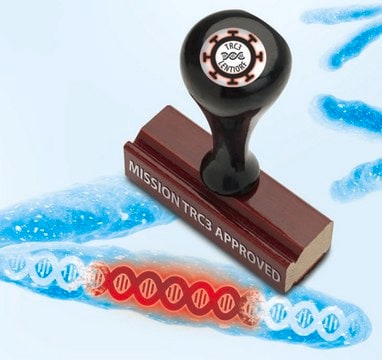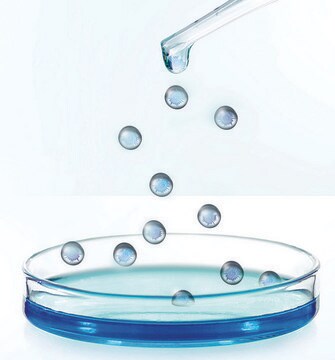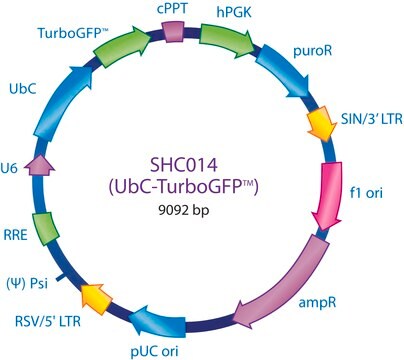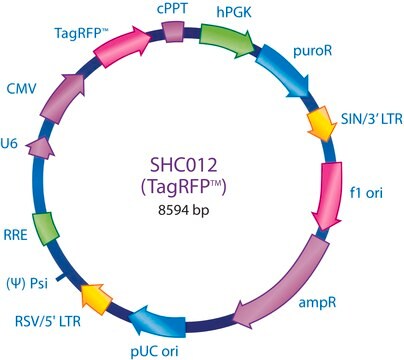ORFGFPV
3355 Kontrola lentiwirusa TRC3 ORF GFP
Synonim(y):
Kontrola lentiwirusów, Lentiwirus ORF GFP, Wektor kontrolny lentiwirusa
Zaloguj sięWyświetlanie cen organizacyjnych i kontraktowych
About This Item
Kod UNSPSC:
41106609
NACRES:
NA.51
Polecane produkty
opakowanie
vial of 200 μL
Poziom jakości
stężenie
1x106 VP/ml (via p24 assay)
Zastosowanie
genome mapping
genomic analysis
Warunki transportu
dry ice
temp. przechowywania
−70°C
Powiązane kategorie
Opis ogólny
Cząsteczki transdukcyjne MISSION TRC3 ORF GFP Lentivirus Control Transduction Particles zawierają insert ORF wyrażający 3445 i są przydatne jako kontrola pozytywna (lub negatywna) w eksperymentach wykorzystujących kolekcję bibliotekLentiORF MISSION TRC3 w formacie tablicowym lub pulowym, w tym naszą najnowszą pulę WholeGenome LentiORF Pool. TurboGFP jest ulepszonym wariantem zielonego białka fluorescencyjnego copGFP sklonowanego z Copepoda Pontellina plumata.
Cząsteczki transdukcyjne TurboGFP ORF są wytwarzane z plazmidu lentiwirusowego pLX307-puro-TurboGFP (ORFGFP) o zweryfikowanej sekwencji. Ta pozytywna kontrola może być wykorzystywana do pomiaru wydajności transdukcji i optymalizacji dostarczania ORF w liniach komórkowych, które nie przeżywają ekspozycji na puromycynę. Kontrola GFP zawiera gen kodujący TurboGFP napędzany przez promotor EF1a. Kontrola ta zapewnia szybkie wizualne potwierdzenie udanej transdukcji. Geny oporności na antybiotyki ampicylinę i puromycynę zapewniają selekcję odpowiednio w komórkach bakterii lub ssaków.
W przeciwieństwie do mysich systemów retrowirusowych MMLV lub MSCV, cząsteczki oparte na lentiwirusach umożliwiają skuteczną infekcję i integrację konstruktu w zróżnicowanych i nie dzielących się komórkach, takich jak neurony i komórki dendrytyczne, przezwyciężając trudności związane z niską transfekcją i integracją podczas korzystania z tych linii komórkowych. Samoaktywujące się, niekompetentne replikacyjnie cząsteczki wirusowe są wytwarzane w komórkach pakujących (HEK293T) poprzez współtransfekcję z kompatybilnymi plazmidami pakującymi.
Ponadto, kontrolne cząsteczki transdukcyjne są pseudotypowane glikoproteiną otoczki G wirusa pęcherzykowego zapalenia jamy ustnej (VSV-G), umożliwiając transdukcję szerokiej gamy komórek ssaków. 200 μl cząstek lentiwirusowych o stężeniu 106 TU/ml (w teście miareczkowania p24) jest dostarczanych jako zamrożony zapas.
Podczas przeprowadzania eksperymentów z użyciem klonów MISSION TRC3 ORF, odpowiednie kontrole powinny być kluczowym elementem projektu eksperymentalnego, aby umożliwić dokładną interpretację wyników ekspresji genów i białek. Kontrolne cząsteczki transdukcyjne MISSION są krytyczną kontrolą pozytywną do monitorowania wydajności transdukcji.
Aby zobaczyć dane aplikacji, protokoły, mapy wektorów i więcej odwiedź stronę informacyjną TRC3.
Cząsteczki transdukcyjne TurboGFP ORF są wytwarzane z plazmidu lentiwirusowego pLX307-puro-TurboGFP (ORFGFP) o zweryfikowanej sekwencji. Ta pozytywna kontrola może być wykorzystywana do pomiaru wydajności transdukcji i optymalizacji dostarczania ORF w liniach komórkowych, które nie przeżywają ekspozycji na puromycynę. Kontrola GFP zawiera gen kodujący TurboGFP napędzany przez promotor EF1a. Kontrola ta zapewnia szybkie wizualne potwierdzenie udanej transdukcji. Geny oporności na antybiotyki ampicylinę i puromycynę zapewniają selekcję odpowiednio w komórkach bakterii lub ssaków.
W przeciwieństwie do mysich systemów retrowirusowych MMLV lub MSCV, cząsteczki oparte na lentiwirusach umożliwiają skuteczną infekcję i integrację konstruktu w zróżnicowanych i nie dzielących się komórkach, takich jak neurony i komórki dendrytyczne, przezwyciężając trudności związane z niską transfekcją i integracją podczas korzystania z tych linii komórkowych. Samoaktywujące się, niekompetentne replikacyjnie cząsteczki wirusowe są wytwarzane w komórkach pakujących (HEK293T) poprzez współtransfekcję z kompatybilnymi plazmidami pakującymi.
Ponadto, kontrolne cząsteczki transdukcyjne są pseudotypowane glikoproteiną otoczki G wirusa pęcherzykowego zapalenia jamy ustnej (VSV-G), umożliwiając transdukcję szerokiej gamy komórek ssaków. 200 μl cząstek lentiwirusowych o stężeniu 106 TU/ml (w teście miareczkowania p24) jest dostarczanych jako zamrożony zapas.
Podczas przeprowadzania eksperymentów z użyciem klonów MISSION TRC3 ORF, odpowiednie kontrole powinny być kluczowym elementem projektu eksperymentalnego, aby umożliwić dokładną interpretację wyników ekspresji genów i białek. Kontrolne cząsteczki transdukcyjne MISSION są krytyczną kontrolą pozytywną do monitorowania wydajności transdukcji.
Aby zobaczyć dane aplikacji, protokoły, mapy wektorów i więcej odwiedź stronę informacyjną TRC3.
Zastosowanie
Genomika funkcjonalna/badanie nadekspresji/walidacja celu
Uwaga dotycząca przygotowania
Krzywa zabijania Puro i określanie CFU (jednostki tworzenia kolonii) na ml. Przed przeprowadzeniem badań przesiewowych w skali biblioteki należy przeprowadzić dwa wstępne eksperymenty. Odwiedź stronę Strona informacyjna dotycząca puli lentiwirusów lub zapoznaj się z biuletynem technicznym.
Informacje prawne
Korzystanie z tego produktu podlega jednej lub kilku umowom licencyjnym. Szczegółowe informacje można znaleźć na stronie Strona licencji MISSION.
MISSION is a registered trademark of Merck KGaA, Darmstadt, Germany
TurboGFP is a trademark of Evrogen Co.
Ta strona może zawierać tekst przetłumaczony maszynowo.
produkt powiązany
Numer produktu
Opis
Cennik
Kod klasy składowania
12 - Non Combustible Liquids
Klasa zagrożenia wodnego (WGK)
WGK 3
Temperatura zapłonu (°F)
Not applicable
Temperatura zapłonu (°C)
Not applicable
Wybierz jedną z najnowszych wersji:
Certyfikaty analizy (CoA)
Lot/Batch Number
Nie widzisz odpowiedniej wersji?
Jeśli potrzebujesz konkretnej wersji, możesz wyszukać konkretny certyfikat według numeru partii lub serii.
Masz już ten produkt?
Dokumenty związane z niedawno zakupionymi produktami zostały zamieszczone w Bibliotece dokumentów.
Klienci oglądali również te produkty
Global Trade Item Number
| SKU | GTIN |
|---|---|
| ORFGFPV | 4061826599778 |
Nasz zespół naukowców ma doświadczenie we wszystkich obszarach badań, w tym w naukach przyrodniczych, materiałoznawstwie, syntezie chemicznej, chromatografii, analityce i wielu innych dziedzinach.
Skontaktuj się z zespołem ds. pomocy technicznej










